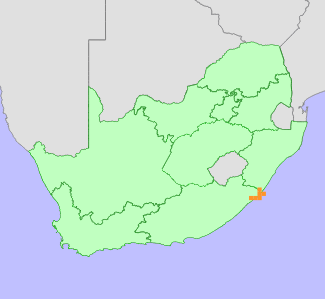|
Scientific Name | Lampranthus fugitans L.Bolus |
Higher Classification | Dicotyledons |
Family | AIZOACEAE |
National Status |
Status and Criteria | Vulnerable C2a(i) |
Assessment Date | 2022/05/11 |
Assessor(s) | P.M. Burgoyne, F. Daniels & H. Mtshali |
Justification | This Pondoland endemic is known in 10 to 15 locations. It has a restricted range, with an extent of occurrence (EOO) of 1750 km², and an area of occupancy (AOO) of 104 km². Based on available monitoring data, the population is estimated to have fewer than 10 000 mature individuals, and the largest subpopulation has between 250 and 500 mature individuals. The population is declining due to too frequent fires, invasion by alien plants, overgrazing and trampling, and resultant soil erosion. It therefore qualifies for listing as Vulnerable under criterion C. |
Distribution |
Endemism | South African endemic |
Provincial distribution | Eastern Cape, KwaZulu-Natal |
Range | This species is endemic to the Pondoland area, where it occurs from Port Edward to Lusikisiki. |
Habitat and Ecology |
Major system | Terrestrial |
Major habitats | Pondoland-Ugu Sandstone Coastal Sourveld |
Description | It is found in open areas on scattered rocky outcrops between grassland, on soils derived from Msikaba Sandstone. |
Threats |
| At least 35% of this species' grassland habitat has already been lost, mainly to agriculture and coastal development. Most of the remaining coastal grassland in the Pondoland region is subjected to overgrazing, too frequent fire, and invasion by alien plants, leading to ongoing degradation and loss of forb diversity. |
Population |
This species was previously known from three locations. Recent field observations recorded this species at 10 locations, and a few more as yet unsurveyed locations are likely to exist as there remains unexplored suitable habitat within its range. A number of the recently monitored subpopulations are declining due to too frequent fires and the invasion of habitat by alien plants. There have been 12 subpopulations monitored between 2013 and 2022; the majority of these are small, consisting of between 10 and 50 mature individuals; only one subpopulation has been recorded to have between 250 and 500 mature individuals. The overall population size is therefore projected to be under 10 000 mature individuals, and no subpopulation has more than 1000 mature individuals. A continuing population decline is inferred from ongoing habitat degradation across this species' range.
|
Population trend | Decreasing |
Assessment History |
Taxon assessed |
Status and Criteria |
Citation/Red List version | | Lampranthus fugitans L.Bolus | VU D2 | Raimondo et al. (2009) | | Lampranthus fugitans L.Bolus | Insufficiently Known | Hilton-Taylor (1996) | | Lampranthus fugitans L.Bolus | Rare | Hall et al. (1980) | |
Bibliography |
Hall, A.V., De Winter, M., De Winter, B. and Van Oosterhout, S.A.M. 1980. Threatened plants of southern Africa. South African National Scienctific Programmes Report 45. CSIR, Pretoria.
Hilton-Taylor, C. 1996. Red data list of southern African plants. Strelitzia 4. South African National Botanical Institute, Pretoria.
Raimondo, D., von Staden, L., Foden, W., Victor, J.E., Helme, N.A., Turner, R.C., Kamundi, D.A. and Manyama, P.A. 2009. Red List of South African Plants. Strelitzia 25. South African National Biodiversity Institute, Pretoria.
|
Citation |
| Burgoyne, P.M., Daniels, F. & Mtshali, H. 2022. Lampranthus fugitans L.Bolus. National Assessment: Red List of South African Plants version 2024.1. Accessed on 2025/12/12 |
 Comment on this assessment
Comment on this assessment


